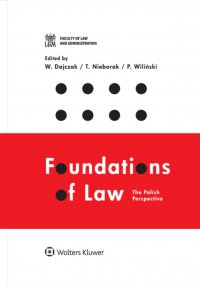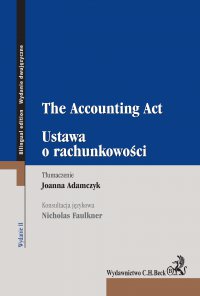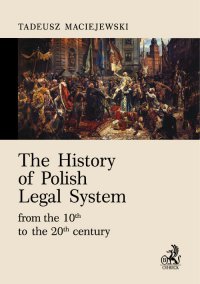Legal English. Handbook and Workbook - ebook
Legal English. Handbook and Workbook - ebook
Legal English. Textbook and Workbook will enable you to understand the language of the law in English; prepare the reader for TOLES examinations. The book is intended for law students who learn English as well as for practiotioners to use the book as a self-study material.
This third edition has been revised and updated.
Doskonała pomoc dla studentów wydziału prawa, optymalna dla prawników-praktyków do samodzielnej nauki.
- Fachowa terminologia angielskiego systemu prawnego.
- 2 w 1 – podręcznik wraz z ćwiczeniami.
- Liczne ćwiczenia przygotowujące do egzaminu TOLES.
- Przedstawienie instytucji prawa anglosaskiego.
- Zasady użycia języka prawniczego w profesjonalnych tekstach.
- Akty prawne w brzmieniu angielskim (pisma sądowe, wyroki etc.).
Trzecie wydanie podręcznika zostało uzupełnione i zaktualizowane.
| Kategoria: | Literatura obcojęzyczna |
| Zabezpieczenie: |
Watermark
|
| ISBN: | 978-83-255-6329-5 |
| Rozmiar pliku: | 1,2 MB |
FRAGMENT KSIĄŻKI
TEST QUESTIONS
TEST QUESTIONS
+------------------------------------------------------------------+--------------------------------------------------------------------------------------------------------------------------------------------+
| 1. What possible meanings does an expression “common law” carry? | According to the context its meaning may differ. |
| | |
| | It may signify law which is common to the whole country – national law in contrast to local law. |
| | |
| | It is law based on judicial decision (case law) in contrast to the law made by Parliament (statute law). |
| | |
| | The expression distinguishes the common law legal systems based on precedents from civil law jurisdictions which are based on civil codes. |
| | |
| | It comprises the rules developed by the common law courts in contrast to the rules developed by the court of equity. |
+------------------------------------------------------------------+--------------------------------------------------------------------------------------------------------------------------------------------+
+-------------------------------------------------------+------------------------------------------------------------------------------------------------------------------------------------------------------------------------------------------------------------------------------------------------------------------------------------------------------------+
| 2. What are the basic characteristics of English law? | It is based on the common law tradition, e. g. a system of judge made law continuously developed over the years through the decisions of judges in cases decided by them. These decisions are called judicial precedents and they form an important preliminary source of law in the English legal system. |
| | |
| | English judges have an important role in developing case law; by judicial precedents as well as by interpreting Acts of Parliament they legislate. |
| | |
| | The judges are independent of both the government and the people appearing before them. They are free to make impartial decisions. |
| | |
| | Court procedure is accusatorial which means that judges do not investigate the cases but reach a decision based only on the evidence presented to them by the parties to the dispute. Such a system is called adversarial. |
+-------------------------------------------------------+------------------------------------------------------------------------------------------------------------------------------------------------------------------------------------------------------------------------------------------------------------------------------------------------------------+
+----------------------------------------------------------------------------+----------------------------------------------------------------------------------------------------------------------------------------------------------------------------------------------------------------------------------------------------------------------------------------------------------------------------------------------------------------------------------------------------------------------------------------------------------------------------------------------------------------------------+
| 3. How does the Polish civil law system differ from the common law system? | In Poland the civil law system has been codified or systematically collected to form a consistent body of legal rules. Thus, it can be said that the rules of the common law system evolved inductively from decision to decisions involving similar facts, so that they are firmly grounded upon the actualities of litigation and the reality of human conduct. New cases lead onwards to reach forward new rules. Its principles are to employ a popular phrase “open ended”; they are not firm and inflexible decrees. |
| | |
| | On the other hand, the task of the court in the civil law systems based on codes is deductive; to subsume the present case under the generalized and codified rule. |
+----------------------------------------------------------------------------+----------------------------------------------------------------------------------------------------------------------------------------------------------------------------------------------------------------------------------------------------------------------------------------------------------------------------------------------------------------------------------------------------------------------------------------------------------------------------------------------------------------------------+
----------------------------------------------- ------------------------------------------------------------------------------------------------------------------------
4. What is the inquisitorial court procedure? In the inquisitorial court procedure it is the function of the judges to investigate the case and to collect evidence.
----------------------------------------------- ------------------------------------------------------------------------------------------------------------------------
----------------------------------------------------------------- -----------------------------------------------------------------------------------------------------------------------------------------------------------------------------------------------------------------------------------------------------------------------------------------------------------------------------------------------------------------------
5. What is a disadvantage of the adversarial system of justice? In the adversarial system of justice the case is decided on the evidence presented to the court by the parties to the action. This evidence is subjective in that it is in favour of the party presenting it: there is no independent body to investigate the case objectively. This can result in important evidence being ignored and not being heard by the court.
----------------------------------------------------------------- -----------------------------------------------------------------------------------------------------------------------------------------------------------------------------------------------------------------------------------------------------------------------------------------------------------------------------------------------------------------------
------------------------------- ------------------------------------------------------------------------------------------------------------------------------------------------------------------------------------------------------------------------------------------------------------------------------------------------------------------
6. What is the law of Equity? Equity is a special area of English law which was first created by the Lord Chancellor, then developed by the Court of Chancery (now called the Chancery Division of the High Court). It consists of rules and remedies which supplement the common law when this is necessary for justice in a particular case.
------------------------------- ------------------------------------------------------------------------------------------------------------------------------------------------------------------------------------------------------------------------------------------------------------------------------------------------------------------
+-----------------------------------+--------------------------------------------------------------------------------------------------------------------------------------------------------------------------------------------------------------------------------------------------------+
| 7. What are equitable maxims? | The purpose of Equity is to achieve justice and fairness. To do this the courts have developed a set of rules to govern the application of equity. These are called the maxims of equity. They are different from the rules which apply in common law. |
| | |
| | There are many equitable maxims of which the following are just brief examples: |
| | |
| | Equity will not suffer wrong to be without remedy. Equity will only intervene when there is no adequate common law remedy. |
| | |
| | Equity follows the law. Equity recognizes legal rights and does not take the place of the common law. |
| | |
| | He who comes to equity must come with clean hands. A litigant who has behaved unfairly in the dispute will be denied an equitable remedy. |
| | |
| | Equitable remedies are discretionary. Litigants do not have a right to an equitable remedy. The court will decide whether to grant a remedy after considering the individual circumstances of each case. |
+-----------------------------------+--------------------------------------------------------------------------------------------------------------------------------------------------------------------------------------------------------------------------------------------------------+
------------------------------------------------------- ---------------------------------------------------------------------------------------------------------------------------------------------------------------------------------------------------------------------------------------------------------------------------------------------------------------
8. Why is the law of Equity distinct from common law? The maxims of equity are the reason why we continue to distinguish between common law and equity. They are different from the rules that apply in common law, and one of the most important features of equity which distinguishes it from common law is the maxim that equitable remedies are discretionary.
------------------------------------------------------- ---------------------------------------------------------------------------------------------------------------------------------------------------------------------------------------------------------------------------------------------------------------------------------------------------------------
+-----------------------------------+--------------------------------------------------------------------------------------------------------------------------------------------------------------------------------+
| 9. What are law reports? | The judgments in higher courts are published in the series of law reports because they form an important part of the law. They have to be available to lawyers and the public. |
| | |
| | The most common series of law reports are: All England Law Reports, Weekly Law Reports, Queen’s Bench, King’s Bench, Appeal Cases, Chancery, Criminal Law Reports. |
+-----------------------------------+--------------------------------------------------------------------------------------------------------------------------------------------------------------------------------+
--------------------------------------------------- -----------------------------------------------------------------------------------------------------------------------------------------------------------------------------------------------------------------------------------
10. What should be understood by the word “case”? The word “case” in the legal context means the legal action or dispute which has been brought to the court for resolution. The judges’ decision is the law – hence, the English system of law is often referred to as “case” law.
--------------------------------------------------- -----------------------------------------------------------------------------------------------------------------------------------------------------------------------------------------------------------------------------------
+-----------------------------------------------------------------------------------+-----------------------------------------------------------------------------------------------------------------------------------------------------------------------------------------------------------------------------------------------------------------------------------------------------------------------------------------------------------------------------------------------------------------------------------------------------------------------------------------------------------------------------------------------------------------------------+
| 11. What does the standard reference of the report of an individual case contain? | A standard reference tells the reader where the report of an individual case may be found. It contains the year in which the case was published; the name of the publication in abbreviated form and the page number at which the case can be found. When the case reports for a single year are contained in more than one volume of a publication, the number of the volume will appear before the name of the publication, e. g. a case reported at 3 All E R 365 will be found in the third volume of the All England Law Reports for the year 1979 at page 365. |
| | |
| | The use of square brackets signifies that the year is essential to finding the case report. If the case is cited with the year only and not the reference, round brackets are used, e. g. Donaghue v. Stevenson (1932). |
| | |
| | Case names are always highlighted in some way, either by italics or if they are handwritten they should be underlined. |
+-----------------------------------------------------------------------------------+-----------------------------------------------------------------------------------------------------------------------------------------------------------------------------------------------------------------------------------------------------------------------------------------------------------------------------------------------------------------------------------------------------------------------------------------------------------------------------------------------------------------------------------------------------------------------------+
---------------------------------------------------------- ---------------------------------------------------------------------------------------------------------------------------------------------------------------------------------------------------
12. What is the “case law” system of judicial precedent? Judges are not free to reach any decision they wish to when they decide the case presented to them; they are bound to follow certain rules and these rules form the system of judicial precedent.
---------------------------------------------------------- ---------------------------------------------------------------------------------------------------------------------------------------------------------------------------------------------------
+----------------------------------------------------+----------------------------------------------------------------------------------------------------------------------------------------------------------------------------------------------------------------------------------------------------------------------------------------------------------------------------------------------------------------------------------------------------------------------------------------------------------------------------------------------------------------------------------------------------------------------------------------------------------------------+
| 13. What is the ratio decidendi and obiter dictum? | A judgment comprises two parts: the ratio decidendi and obiter dictum. It is ratio decidendi which is binding in later cases. The obiter dictum is merely persuasive, that is it may help future judges to reach a decision but they are not bound to follow it. The ratio decidendi of a case is the principle of law on which the decision is based. An obiter dictum means “something said by the way”, thus it comprises some speculations of the judge what his decision would or might have been if the facts of the case had been different. |
| | |
| | The ratio is not a decision itself as only the litigating parties are bound by the actual decision in a case whereas the ratio of a case states the law for all persons and may be binding in later cases. |
| | |
| | It is possible for a judge in a later case to relegate the ratio to the status of obiter dicta. Since the facts of two cases are unlikely to be identical, the judge in the later case usually has the task of either restricting or enlarging the ratio of the earlier case, and therefore the ratio decidendi must always depend on the particular facts of the individual case. To discover the ratio of a case, all the facts found by the judge to be material must be considered. If a judge gives two or more reasons for his decision, they may be both or all rationes decidendi and not mere obiter dicta. |
+----------------------------------------------------+----------------------------------------------------------------------------------------------------------------------------------------------------------------------------------------------------------------------------------------------------------------------------------------------------------------------------------------------------------------------------------------------------------------------------------------------------------------------------------------------------------------------------------------------------------------------------------------------------------------------+
+----------------------------------------------+----------------------------------------------------------------------------------------------------------------------------------------------------------------------------------------------------------------------------------------------------------------------------------------------------------------------------------------------------------------------------------------------------------------------------------------------------------------------------------------------------------------------------------------------------------------------------------------------------------------------------------------------------------------------------------+
| 14. What are typical stages of a case study? | These are: background, complaint, action, defence, judgment, and reasons. |
| | |
| | Miller v. Jackson QB 966 |
| | |
| | The facts: The plaintiffs owned a house adjoining a cricket ground. Cricket has been played on the ground for a long time before the house has been built (background). The plaintiffs complained of damage caused by cricket balls and loss of enjoyment of their property (complaint). They brought an action against the cricket club for private nuisance seeking damages (common law remedy) and an injunction (an equitable remedy) to prevent cricket being played on the ground (action). The cricket club argued that it had done everything that was possible to stop the balls coming into the plaintiffs’ garden, including erecting a fifteen foot fence (defence). |
| | |
| | Held: The cricket club were liable to the plaintiffs for private nuisance. An award of damages was made against them but a majority of the Court of Appeal refused to grant an injunction preventing the playing of cricket (judgment). |
| | |
| | Per Lord Denning MR: The court, when deciding whether to exercise its equitable jurisdiction and grant an injunction, must have in mind that it is under a duty to consider the public interest. Where the effect of granting an injunction would be to prevent cricket being played on a ground where it had been played for seventy years or so, the special circumstances are such that the public interest must prevail over the hardship of the individual householders who were deprived of the ability to enjoy, in peace and quiet, their house and garden while cricket was being played (reasons). |
+----------------------------------------------+----------------------------------------------------------------------------------------------------------------------------------------------------------------------------------------------------------------------------------------------------------------------------------------------------------------------------------------------------------------------------------------------------------------------------------------------------------------------------------------------------------------------------------------------------------------------------------------------------------------------------------------------------------------------------------+
+-------------------------------------------------------+--------------------------------------------------------------------------------------------------------------------------------------------------------------------------------------------------------------------------------------------------------------------------------------------------------------------------------------------------------------------------------------------------------------------------------------------------------------------------------------------------------------------------------------------------------------------------------------------------------------------------------------------------------------------------------------------------------------------------------------------------------------------------+
| 15. What does the doctrine of the binding case state? | By the doctrine of the binding case the authority of the courts is hierarchical; a court which is inferior in authority to another court is obliged to follow (bound by) a court of superior authority if called upon to decide upon facts similar to facts already tried by the superior court. |
| | |
| | The House of Lords used to be the highest appeal court in the English legal system. Its decisions were binding on all the courts. Until 1966, the House of Lords had also been bound by its own previous decisions. In this year the Lord Chancellor, Lord Gardiner, issued a Practice Statement which stated “while treating former decisions of this House normally binding” their Lordships would “depart from a previous decision when it appears right to do so”. |
| | |
| | In 2009 The Supreme Court of the United Kigdom started to work as the highest appeal court in the English legal system. |
| | |
| | The Court of Appeal is below the Supreme Court. It is bound by the decisions of the Supreme Court and its decisions are binding on all lower courts. It is also bound to follow its own previous decisions except when a previous decision of the Court of Appeal conflicts with the decision of the Supreme Court, or there are two conflicting Court of Appeal decisions when it must choose which one to follow, and when a previous decision was given per incuriam (through lack of care – generally when some relevant law was not taken into consideration). These exceptions to the rule that the Court of Appeal must abide by its own decisions are called the rules in Young v. Bristol Aeroplane Company (1944), the case in which the rules were laid down. |
| | |
| | The court below the Court of Appeal is the High Court of Justice. It is bound to follow the decisions of the House of Lords and the Court of Appeal. Judges in the High Court will normally follow the decisions of fellow High Court judges but they are not absolutely obliged to do so. |
| | |
| | The court of first instance for criminal cases, the Crown Court, is bound by the House of Lords and the Court of Appeal; the lowest courts in the hierarchy, the county courts and the magistrates’ courts are bound by the High Court, the Court of Appeal and the House of Lords. No court is bound by the decisions of these lower courts. |
+-------------------------------------------------------+--------------------------------------------------------------------------------------------------------------------------------------------------------------------------------------------------------------------------------------------------------------------------------------------------------------------------------------------------------------------------------------------------------------------------------------------------------------------------------------------------------------------------------------------------------------------------------------------------------------------------------------------------------------------------------------------------------------------------------------------------------------------------+
------------------------------------------------------------------------
Zapraszamy do zakupu pełnej wersji książki
------------------------------------------------------------------------
BESTSELLERY

 Wydawnictwo: C. H. BeckFormat: PDFZabezpieczenie: Watermark VirtualoKategoria: Literatura obcojęzycznaKompendium wiedzy o egzaminie oraz wykonywaniu zawodu tłumacza przysięgłego. Opracowanie zawiera praktyczny komentarz do przepisów ustawy, wzory dokumentów oraz przykładowe teksty egzaminacyjne w ośmiu językach angielskim, niemieckim, ...149,00 zł149,00 zł
Wydawnictwo: C. H. BeckFormat: PDFZabezpieczenie: Watermark VirtualoKategoria: Literatura obcojęzycznaKompendium wiedzy o egzaminie oraz wykonywaniu zawodu tłumacza przysięgłego. Opracowanie zawiera praktyczny komentarz do przepisów ustawy, wzory dokumentów oraz przykładowe teksty egzaminacyjne w ośmiu językach angielskim, niemieckim, ...149,00 zł149,00 zł
 Wydawnictwo: Wolters KluwerFormat: PDFZabezpieczenie: Watermark VirtualoKategoria: Literatura obcojęzyczna“Foundations of Law: The Polish Perspective” covers a range of issues forming the core of academic legal education in Poland. It provides basic knowledge about Polish law and Polish legal culture, and constitutes an innovative introduction ...76,00 zł76,00 zł
Wydawnictwo: Wolters KluwerFormat: PDFZabezpieczenie: Watermark VirtualoKategoria: Literatura obcojęzyczna“Foundations of Law: The Polish Perspective” covers a range of issues forming the core of academic legal education in Poland. It provides basic knowledge about Polish law and Polish legal culture, and constitutes an innovative introduction ...76,00 zł76,00 zł- 189,00 zł

 Wydawnictwo: C. H. BeckFormat: PDFZabezpieczenie: Watermark VirtualoKategoria: Literatura obcojęzycznaDrugie wydanie tłumaczenia ustawy o rachunkowości na język angielski stanowi próbę oddania w języku angielskim zagadnień polskiej rachunkowości w sposób jak najbardziej zbliżony do konwencji obowiązujących w tym zakresie w ...189,00 zł189,00 zł
Wydawnictwo: C. H. BeckFormat: PDFZabezpieczenie: Watermark VirtualoKategoria: Literatura obcojęzycznaDrugie wydanie tłumaczenia ustawy o rachunkowości na język angielski stanowi próbę oddania w języku angielskim zagadnień polskiej rachunkowości w sposób jak najbardziej zbliżony do konwencji obowiązujących w tym zakresie w ...189,00 zł189,00 zł
 Wydawnictwo: C. H. BeckFormat: PDF EPUB MOBIZabezpieczenie: Watermark VirtualoKategoria: Literatura obcojęzycznaTextbook is an attempt to present the history of Poland’s state system and law from the earliest times up to the present. Generally speaking, this publication is intended for Polish students who are studying law in English.199,00 zł199,00 zł
Wydawnictwo: C. H. BeckFormat: PDF EPUB MOBIZabezpieczenie: Watermark VirtualoKategoria: Literatura obcojęzycznaTextbook is an attempt to present the history of Poland’s state system and law from the earliest times up to the present. Generally speaking, this publication is intended for Polish students who are studying law in English.199,00 zł199,00 zł





